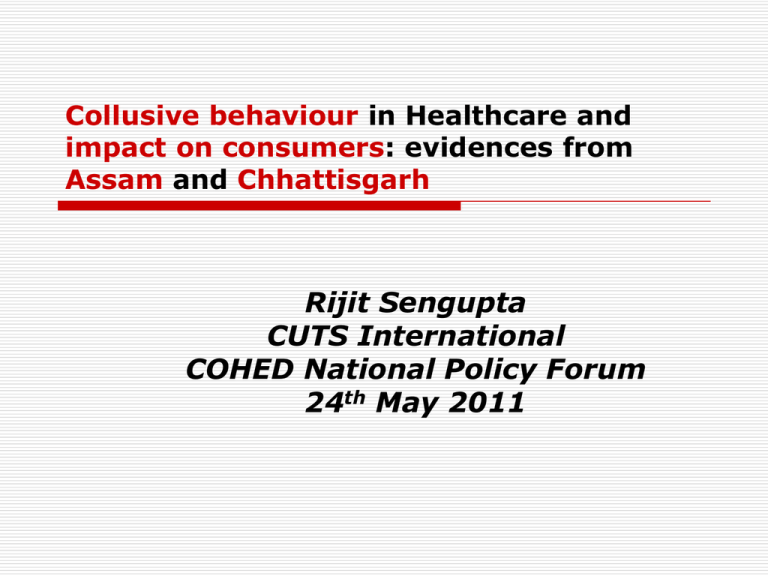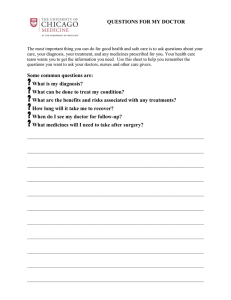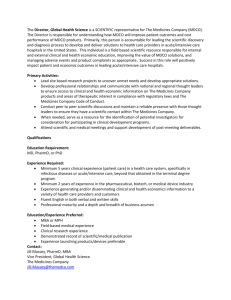Rijit Sengupta CUTS International COHED National Policy Forum 24
advertisement

Collusive behaviour in Healthcare and impact on consumers: evidences from Assam and Chhattisgarh Rijit Sengupta CUTS International COHED National Policy Forum 24th May 2011 Outline of Presentation Introduction CUTS study findings COHED project Findings of the First Stage Findings of the Second Stage Conclusions & Way forward I. INTRODUCTION Mamoni Das visits a public hospital in Guwahati, expecting quality treatment at affordable cost She is seen by a doctor and given a prescription containing a list of medicines Approaches public pharmacy, for free medicines Mamoni is informed that medicines written in the prescription are not available and has to get them from the private chemist, outside She buys the medicines with whatever little money she had come to the hospital with… What did we find? 49% of the medicines that Mamoni Das and some of the other patients had to buy from private sources after visiting the public hospital were present in the Hospital Stock Register 9% of the medicines that were absent in the Hospital Stock Register had substitutes, that were present in the Stock WHY DID MAMONI HAVE TO BUY MEDICINES FROM PRIVATE CHEMISTS? Possible Reasons? Docs did not know the status of the medicines in the Hospital Stock Register, and suggested that ‘good quality/effective’ medicines be bought from outside Mamoni Das was a victim of ‘collusive arrangements’ between various entities inside and outside the public hospital What is Collusion/Collusive Practice? Collusion refers to combinations, conspiracies or agreements among sellers to raise or fix prices and to reduce output/supplies in order to increase profits (OECD, 2002) DID THE PLAYERS (in the public hospital Mamoni visited) ENTER INTO AGREEMENTS TO REDUCE SUPPLY OF MEDICINES through the public distribution channel? A Grim Picture! Competition Act 2002 of India The Competition Act 2002 of India prohibits ‘………enterprises or associations of enterprises (or persons or association of persons) from entering into any agreement in respect of production, supply, distribution, storage……..which has an appreciable adverse effect on competition’. Agreements having such effects on competition result in - determining purchase or sale prices; limiting or controlling production/supply/marketing/development/provision of services; geographical allocation of markets; and collusive bidding. Competition Commission of India is sufficiently empowered and should investigate if supply and distribution of medicines in these public hospitals have been restricted due to collusive agreements between various players II.COHED Project Goal: Gather evidence of collusive practices and assess if some of them infringed the provisions of the India Competition Act 2002, or could be addressed through other regulatory instruments Objectives To identify market malpractices in healthcare in 2 states To assess scope and effectiveness of the present regulatory system to deal with malpractices/collusion To make recommendations for better regulatory outcomes To spread awareness about these recommendations and lay the ground for their implementation II.COHED Project (Contd.) Research based Advocacy States: Assam & Chhattisgarh Partnership with local NGOs Field-work and Data Analysis 2-stage Survey - First Stage: Consumer Survey - Second Stage: Prescription analysis III. FIRST STAGE: Consumer Survey 3 towns in each state Public Hospitals Consumer information household expenditure on healthcare, behaviour of heathcare providers, availability of healthcare services, prices of such services, etc. Findings: - Tendency of choosing private healthcare service (often to suit convenience and save time, etc.) existed - Common belief: simple correlation exists between cost of healthcare & its quality III. FIRST STAGE: Consumer Survey (Contd.) - - - In addition to greater consumer awareness, there is also a need for change in consumer’s attitude towards healthcare Private healthcare suffers from high degree of variation and there is hardly any regulation to maintain a minimum standard An extremely high frequency of referrals (to diagnostic clinics) combined with the prevalence of ‘cuts’ for referring doctors was noted In spite of having received medical treatment at a public hospital, many consumers bought medicines from private sources WE DECIDED TO DIG DEEPER………. IV. SECOND STAGE: Prescription Analysis Same towns as the first stage Prescriptions collected to assess cost of medicines, availability of medicines in public hospital, etc. Common Findings - large number of respondents bought medicines from private sources - Non-availability of drugs in public hospital is not uncommon - Insistence by docs to buy drugs from outside - High degree of prevalence of ‘incompleteness of diagnosis’ Cost to Consumers & Availability of Medicines Cost of Medicines vis-a-vis Source 450 120 382 Cost of Medicines vis-a-vis Source 100 300 80 250 60 200 163 150 40 115 33 100 20 400 80 250 66 200 60 140 150 40 100 66 20 50 0 6 0 0 0 Dr Am bedkar Hospital, Raipur 1.5 District Hospital, Pandri 0 District Hospital, Durg CIMS, Bilaspur Hospitals in Chhattisgarh 120 Avg Cost of Prescription (Rs.) Private Source of Medicines (%) 28 28 8 5 0 0 3 Seldom 35 Never 19 3 0 1 0 Percentage Often 45 District Hospital, Pandri District Hospital, Durg Hospitals in Chhattisgarh CIMS, Bilaspur 70 60 Always 50 40 30 35 Often Seldom 39.5 33.5 38 27 26 18 20 10 Dr Ambedkar Hospital, Raipur 70 70 Always 60 Private Source of Medicines (%) Procurement of Medicines from Private Sources 80 69 59 Avg Cost of Prescription (Rs.) Hsopitals in Assam 97 90 0 Civil Hospital, Urban Health Guw ahati Public Health Nagaon Centre, Medical Institutions, Nagaon Colleage & Bongaigaon Hospital Procurement of Medicines from Private Sources Percentage 100 98 94 300 50 30 120 374 350 Cost of Medicine (Rs) Cost of Medicine (Rs) 92.5 Medicine obtained from Private sources(%) 99 350 Medicines obtained from Private Sources (%) 400 13 6 Never 17 6 1 0 0 0 Civil Hospital, Nagaon Urban Health Centre, Nagaon Guw ahati Medical Colleage & Hospital Hospitals in Assam Public Health Institutions, Bongaigaon Completeness of Diagnosis Completeness of Diagnosis Completeness of Diagnosis 120% 120 41 58 32 Percentage Percentage 90% 49 60% 30% 59 42 68 90 45 60 30 51 55 8 0 0% Dr District District CIMS, Am bedkar Hospital, Hospital, Bilaspur Hospital, Pandri Durg Raipur Hospitals in Chhattisgarh 90 92 Incomplete 10 0 Civil Hospital, Urban Health Nagaon Centre, Nagaon Guw ahati Medical Colleage & Hospital Complete Hospitals in Assam Public Health Institutions, Bongaigaon Incomplete Complete IV. SECOND STAGE: Account of Medical Representatives Three types of malpractices: - Reminders - Inducements - Cash payments and bribes Innovative ways of ‘keeping track of sales’, for cash reimbursements V. Conclusions & Way forward Issues for Policy - Procurement and Distribution of medicines - Public display of hospital stock - Periodic scrutiny of Prescriptions - Identify and adopt state level good practices’ - Greater attention towards patients - Adoption of Clinical Establishment Act, 2010 in states Conclusions & Way forward Issues for Consumer Action - More careful in choosing provider(s) - Approach consumer forum for redressal - Raise demand for generic drugs - Demand discounts CUTS IS GOING TO TAKE THESE FORWARD IN THE STATES……….. Ending thoughts Endeavour to make Mamoni Das’s future visits to the public hospitals more pleasant and less costly!! Thank You Email: rsg@cuts.org Cell:+91-9829285928



